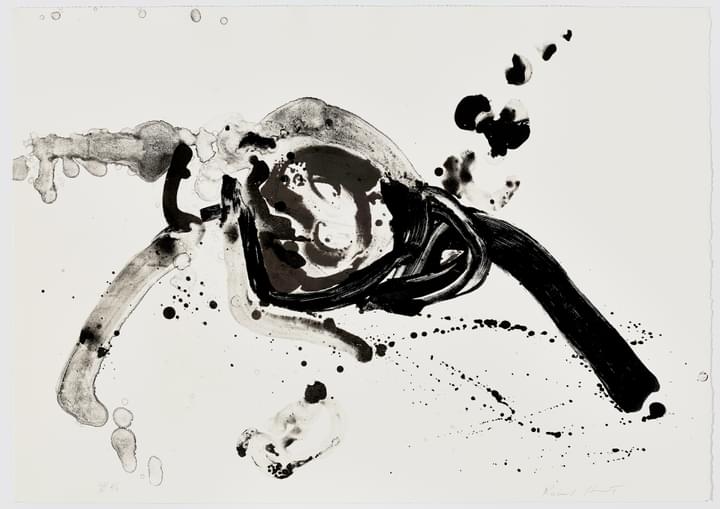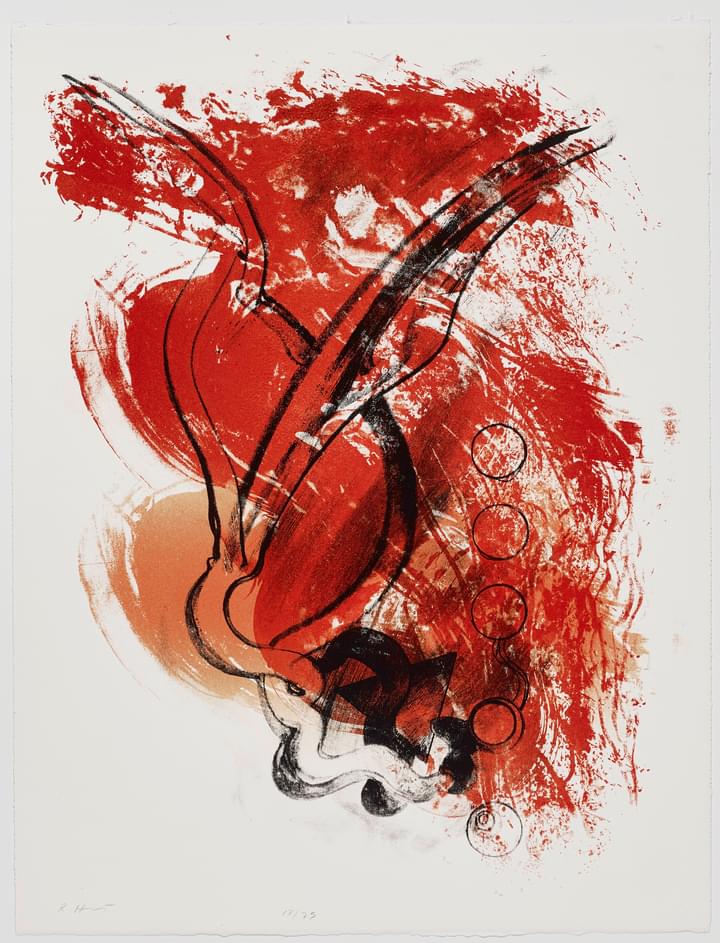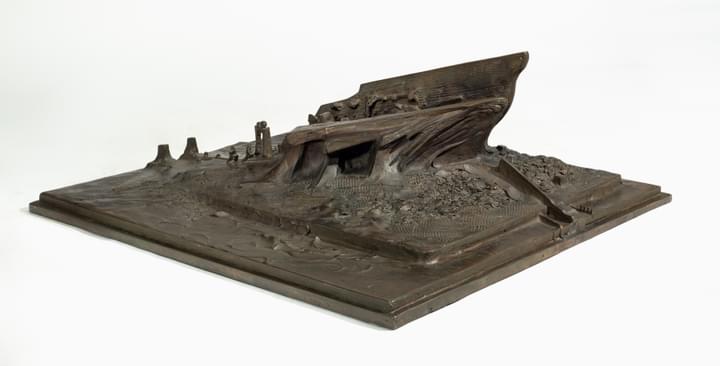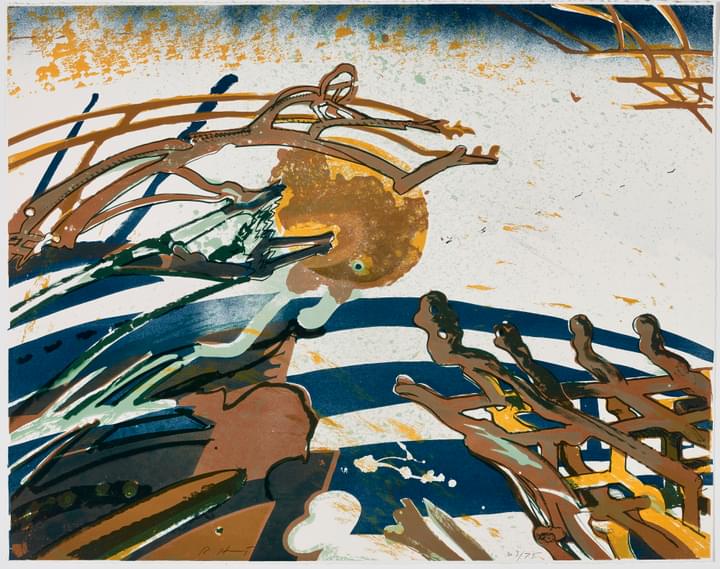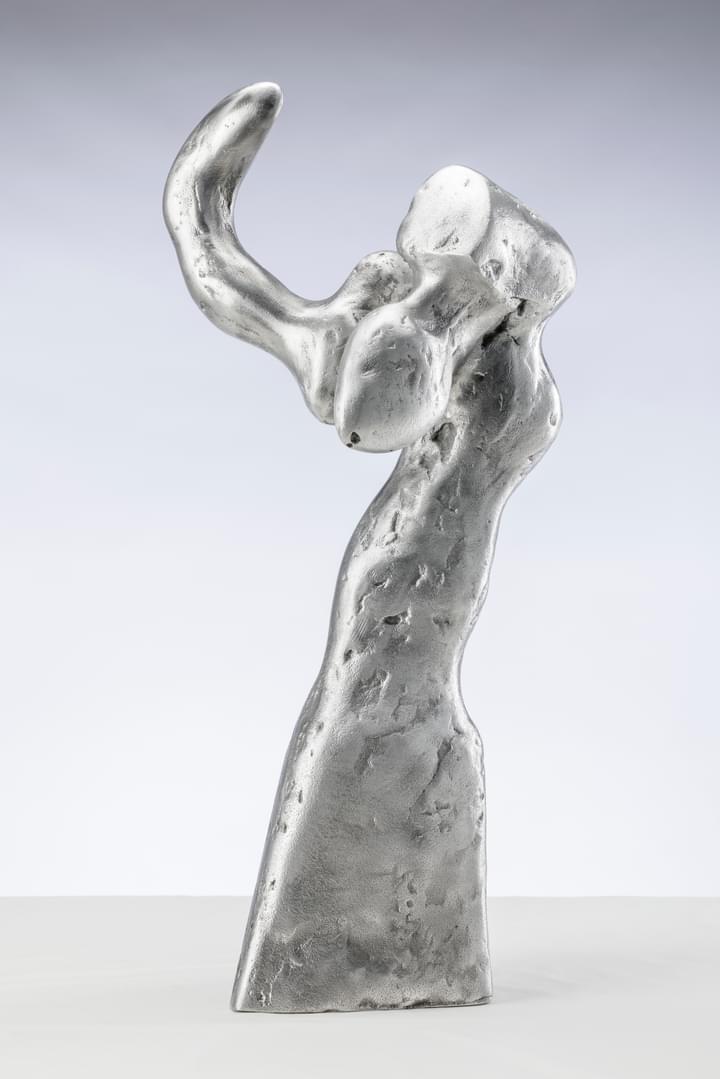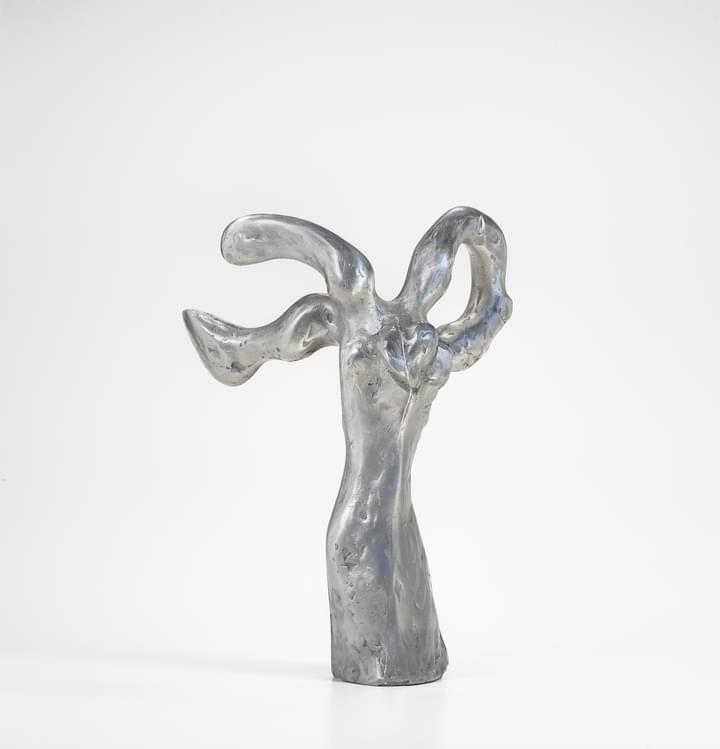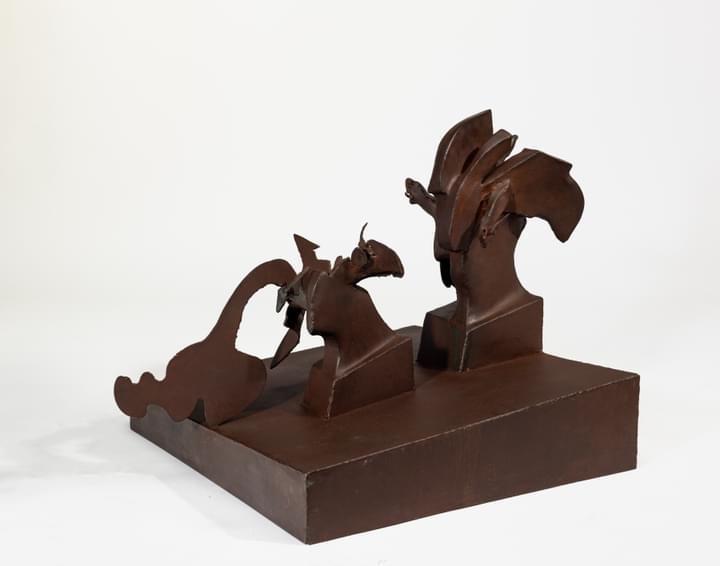Born in 1935 on the South Side of Chicago, Hunt’s journey as a sculptor began at the age of 14, working initially with clay in a studio he built in his bedroom, later moving to the basement of his father’s barbershop. In the spring of 1953, he encountered the work of Spanish sculptor Julio González in the exhibition ‘Sculpture of the Twentieth Century’ at the Art Institute of Chicago. González’s forged, hammered and welded metal sculptures became one of the formative influences on the young artist. Hunt enrolled at the School of the Art Institute of Chicago in the autumn of that year, where he earned his Bachelor of Arts. Inspired in part by González, he transitioned away from soft materials and devoted himself exclusively to metal, teaching himself to solder, and later weld, discarded metal that he scavenged from local scrapyards in Chicago. By 1955, Hunt would sell his soldered wire sculptures, paintings and drawings at local art fairs and galleries, marking the formal beginning of his career as an artist.
With a profound fascination for biological science and the natural world, Hunt meditated on trajectories of metamorphosis, from basic cell division to more complex evolutions. In the artist’s alloying of mechanical and organic vocabularies, Hunt’s abstract sensuosity acknowledges the inherent, unique possibilities of metal, unrivalled by any other sculptural materials be that clay, stone or wood.
The material presence of metal, along with its natural hue variations and tensile properties, enabled him to craft forms that extended into space in ways unattainable with other materials. By repurposing salvaged materials, Hunt’s sculptures exemplify his approach to deconstruction as a means of renewal and growth, a notion further realised through his rearticulation of previous titles or utilisation of a ‘grafting’ method, in which the artist welded parts of old works to cultivate new, hybrid forms. Both approaches suggest a material and discursive life that is blossoming and billowing, affirming natural forms in constant evolution.
‘It is my intention to develop the kind of forms Nature might create if only heat and steel were available to her.’ – Richard Hunt, quoted in exhibition flier, ‘Richard Hunt’, University of Notre Dame Art Gallery, Notre Dame, Indiana, 1966.
In 1957, New York’s Museum of Modern Art (MoMA) acquired Hunt’s steel sculpture, Arachne (1956), earning Hunt national recognition. This achievement, accomplished at the age of 21, coincided with a pivotal juncture in American history – a time marked by racial inequality coupled with the beginnings of the civil rights movement. The brutal, racially-charged murder of Emmett Till in 1955, a fellow Chicagoan and African American who became a symbol of the cause, had a profound impact on Hunt. Throughout his life and work, the civil rights movement remained a driving force, shaping Hunt’s artistic process as he commemorated those individuals central to the movement. In 1971, at the age of 35, Hunt achieved a historic milestone by becoming the first African American sculptor to have a retrospective at MoMA, New York. The exhibition featured 55 sculptures, eight drawings and 12 prints.
Through metal, Hunt engaged in an iterative process – trialling, refining and rearticulating thematic threads, techniques of expansion and metamorphic trajectories. Drawn to the material’s capacity for linearity, malleability and spatial dynamism, he produced a series of expansive, open-form sculptures in the late 1950s and early 1960s that reflect his deepening engagement with the expressive potential of line. Described by the artist as ‘drawings in space’, these works reveal his unique approach to the medium as a form of three-dimensional gesture. In several of these sculptures, collectively titled the ‘Metamorphosis’ series, Hunt’s sustained fascination with Greek and Roman mythology is made manifest, drawing upon the narratives of Ovid’s Metamorphoses as a conceptual framework.
Reflecting his explorations beyond sculptural form, Hunt engaged with drawing and printmaking from the outset of his career – disciplines he regarded both as autonomous modes of expression and as mediums in dialogue with his three-dimensional practice. Working across a range of materials, including black ink, graphite and charcoal, he articulated abstract organic forms through a repertoire of techniques: manipulating surfaces through erasure and smudging, and generating textural variation through dry brush applications. In early works on paper, he brushed opaque white watercolour over layers of black media, then reintroduced passages of black to build dense layers of embedded imagery. These working methods found a parallel in his explorations of lithography, undertaken during his 1965 fellowship, awarded by the Ford Foundation, at the Tamarind Lithography Workshop in Los Angeles, where he collaborated closely with master printer Kenneth E. Tyler. Initially creating densely populated imagery composed of multi-layered forms, he later simplified his approach, rendering more emphatic, abstracted strokes that were often sparsely dispersed across the printing matrix. His collaborations with master printers continued throughout his career, resulting in a body of work that included lithographs, as well as screenprints, carborundum prints, relief prints and handmade paper works.
In keeping with his thematic explorations of growth, freedom and the interplay between industrial materials and organic forms, the sculptor sustained an engagement with public spaces. In 1967, Hunt initiated work on Play, a commissioned sculpture that could not be accommodated within his studio. This endeavour led Hunt to collaborate with craftsmen and to use specialised machinery at a metal fabrication shop, marking the beginning of a new chapter in his artistic journey – that of public sculpture. Exploring the possibilities of site-specificity, Hunt expanded his focus to encompass the interaction of sculpture and the space occupied. In this newfound situatedness, the amorphous and enigmatic rhythms of Hunt’s sculptures became intensified. Notable among Hunt’s public commissions are the welded bronze sculpture, Swing Low (2016), installed as the centrepiece of the National Museum of African American History and Culture in Washington, DC, and The Light of Truth (2021), a monument dedicated to the journalist and civil rights activist Ida B. Wells-Barnett.
Throughout his seven decade-long career, Hunt staged over 170 solo exhibitions and secured more than 160 large-scale public sculpture commissions worldwide. Among his works, Hunt paid tribute to some of his nation’s greatest heroes, including Martin Luther King Jr., Mary McLeod Bethune, Jesse Owens, Hobart Taylor Jr. and Ida B. Wells-Barnett. In 2022, Barack Obama commissioned Hunt to create a sculptural work for the Obama Presidential Centre in Chicago. Book Bird will grace the Library Reading Garden outside the new Chicago Public Library branch on the campus.
Richard Hunt (1935–2023) was born in Chicago, Illinois, where he lived and worked. Throughout his career, he exhibited extensively. Solo exhibitions of his work include White Cube, New York (2024); Amon Carter Museum of American Art, Fort Worth, Texas (2024); Abraham Lincoln Presidential Library and Museum, Springfield, Illinois (2024); KANEKO, Omaha, Nebraska (2022); Norton Simon Museum, Pasadena, California (2022); Art Institute of Chicago, Illinois (2020–21); Georgia Museum of Art, University of Georgia, Athens (2018); Studio Museum in Harlem, New York (2016); Museum of Contemporary Art Chicago, Illinois (2014–15); Peninsula Fine Arts Center, Newport News, Virginia (2011); and David Findlay Jr Gallery, New York (2011). His work is held in over 125 public collections including Buffalo AKG Art Museum, New York; Art Institute of Chicago, Illinois; The British Museum, London; Cleveland Museum of Art, Ohio; Detroit Institute of Arts, Michigan; Hirshhorn Museum and Sculpture Garden, Smithsonian Institution, Washington, DC; The Metropolitan Museum of Art, New York; Museum of Contemporary Art, San Diego, California; MFA, Houston, Texas; MoMA, New York; National Museum of African American History and Culture, Washington, DC; Smithsonian American Art Museum, Washington, DC; Storm King Art Center, Mountainville, New York; Studio Museum in Harlem, New York; and Whitney Museum of American Art, New York, among others.
Hunt was the recipient of numerous awards, among which were the John Simon Guggenheim Memorial Fellowship (1962–63); the Lifetime Achievement Award from the International Sculpture Center (2009); the Fifth Star Award from the City of Chicago (2014); and the Legends and Legacy Award from the Art Institute of Chicago (2022).







